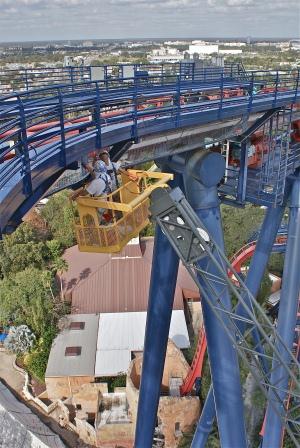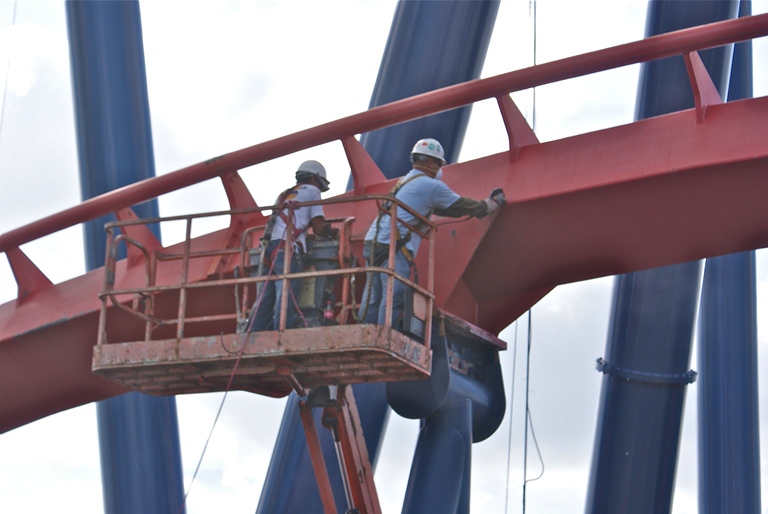Thousands of visitors, young and old alike, flock to theme parks each year to enjoy the myriad attractions and shows — and to ride the heart-pounding roller coasters. That’s why keeping the park’s rides and surrounding grounds aesthetically appealing and in top condition is priority-one for owners.
Paul Weigel, president of Service Painting Corporation (SPC) in Tampa, Fla., is no stranger to the unique challenges associated with theme park maintenance. For more than 30 years, park owners across the United States have relied on the company’s highly acclaimed track record to keep their attractions safe and looking their best. SPC is a long-time service provider to Busch Gardens theme park, also located in Tampa. Owned by SeaWorld Parks and Entertainment, Busch Gardens is open 365 days per year and provides visitors with unique up-close experiences including animal encounters, spectacular shows, and thrilling rides.
One of the park’s most popular roller coasters, SheiKra, is a curling ribbon of steel track that climbs 200 feet (61 m) in the air and stops before sending thrill-seekers down a sheer vertical drop at 70 mph (113 km/h), around 360-degree loops, through an underground tunnel, and into a final splash landing that sprays water 40 feet (12 m) high. The experience leaves riders breathless, but during a routine maintenance check in the spring of 2011, experts wanted to make sure that the ride would also keep riders safe.
What Weigel and SPC Project Manager Robert Pope, along with a Busch Gardens senior engineer, found was that the ride was fading from constant exposure to weather, high levels of humidity, and the intense Florida heat, which can cause structural steel to reach temperatures in excess of 150° F (66° C) during the hottest days of summer. They decided the ride was in dire need of repainting, and Weigel was asked to prepare specifications for an appropriate recoating plan that would restore the bright luster of the ride’s signature red and blue colors, while providing long-term corrosion protection to the ride’s steel substrate.
Another Twist
As the bid process for an acceptable coatings system progressed, it was clear that the project would present several logistical challenges far beyond corrosion protection. The SheiKra roller coaster encompasses 275,000 square feet  (25,548 m²) of surface area and is extremely tall, long, and narrow. This made the ride extremely difficult to access without a crane and multiple man-lifts. Additionally, a separate attraction ran directly underneath one of the roller coaster’s turns, which would require that all work momentarily cease while the train passed under the work area.
(25,548 m²) of surface area and is extremely tall, long, and narrow. This made the ride extremely difficult to access without a crane and multiple man-lifts. Additionally, a separate attraction ran directly underneath one of the roller coaster’s turns, which would require that all work momentarily cease while the train passed under the work area.
With the safety of its team members, guests, and animals as Busch Garden’s primary concern, special containment would also have to be constructed to protect the thousands of daily visitors and employees that needed to walk through the construction area to access adjacent attractions and restaurants. In addition, all work areas were required to be cleaned throughout the day to preserve the park’s impeccable image. Finally, a very large area of concrete was slated for removal from the surrounding work area, but it was located right in the path that the heavy equipment would have to occupy for the re-coating work. This forced a tighter construction schedule with all painting to be completed within a short 35-day window.
Splash Down
In January 2013, with the International Paint coatings system having been selected for the project and all structural repairs to the ride completed, SPC was given the green light to begin repainting SheiKra. Three hundred feet (91 m) of the “run out” area required 100 percent containment. Weigel constructed the containment system from the same fabric that car manufacturers use to make vehicle air bags. He purchased the air  bag cloth in long 50-foot (15 m) sheets that are 30-feet (9 m) wide. The sheets are then sewn together with double seams and grommets that are strategically placed for easy tie-down. The heavy-duty impervious material can withstand winds of up to 200 mph (322 km/h), yet it is translucent enough for daylight to stream in and allow painters to work without additional lighting. Once the containment system was in place, shifts of six crew members began surface preparation of the area.
bag cloth in long 50-foot (15 m) sheets that are 30-feet (9 m) wide. The sheets are then sewn together with double seams and grommets that are strategically placed for easy tie-down. The heavy-duty impervious material can withstand winds of up to 200 mph (322 km/h), yet it is translucent enough for daylight to stream in and allow painters to work without additional lighting. Once the containment system was in place, shifts of six crew members began surface preparation of the area.
Wearing Occupational Safety and Health Administration (OSHA)-approved safety equipment that included wet suits, hard hats, rubber gloves, and 3M safety glasses, the crew pre-cleaned 200 feet (61 m) of steel track. They used CHLOR*RID to remove the chlorine and chemical buildup that comes with repeated exposure to the “pool” water in the ride’s splash zone. They then power-washed the solvent at 3,000 psi (21 mPa) using a G-force pump. Next, crews conducted a Society for Protective Coatings (SSPC) Surface Preparation (SP) 10: Near-White Blast Clean. They used 20/30 mesh Black Beauty slag with a customized blast unit designed by Weigel powered by a 1500 CFM (2,549 m³/h) Caterpillar compressor. The surface was again power-washed with CHLOR*RID, rinsed, and dried with clean air before the crew moved onto applying the coatings.
Want to know how Service Painting Corporation met the adrenaline-rushing challenges of this project? Tune in for the article’s second online installment in July 2014.
